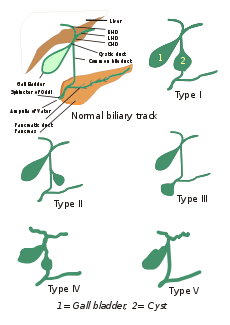Choledochal cysts
| Choledochal cysts | |
|---|---|
 Different types of choledochal cysts | |
| Classification and external resources | |
| ICD-10 | Q44.4 |
| ICD-9 | 751.69 |
| DiseasesDB | 2527 |
| eMedicine | article/172099 article/366004 article/934267 |
| MeSH | D015529 |
Choledochal cysts (aka bile duct cyst) are congenital conditions involving cystic dilatation of bile ducts.[1] They are uncommon in western countries[2] but not as rare in East Asian nations like Japan and China.
Signs and symptoms
Most of them present in 1st year of life; adult presentation is rare and usually at this stage is associated with complication . Classic triad of intermittent abdominal pain, jaundice, and a right upper quadrant abdominal mass is found only in minority of patients.
Diagnosis
Direct Hyperbilirubinemia
Types
They were classified into 5 types by Todani in 1977.[3]
Classification was based on site of the cyst or dilatation. Type I to IV has been subtyped.
- Type I: Most common variety (80-90%) involving saccular or fusiform dilatation of a portion or entire common bile duct (CBD) with normal intrahepatic duct.
- Type II: Isolated diverticulum protruding from the CBD.
- Type III or Choledochocele: Arise from dilatation of duodenal portion of CBD or where pancreatic duct meets.
- Type IVa: Characterized by multiple dilatations of the intrahepatic and extrahepatic biliary tree.
- Type IVb: Multiple dilatations involving only the extrahepatic bile ducts.
- Type V: Cystic dilatation of intra hepatic biliary ducts. Not the same etiology as Caroli's disease.
- Type VI: An isolated cyst of the cystic duct is an extremely rare lesion. Only single case reports are documented in the literature. The most accepted classification system of biliary cysts, the Todani classification, does not include this lesion. Cholecystectomy with cystic duct ligation near the common bile duct is curative.[4]
Treatment
Choledochal cysts are treated by surgical excision of the cyst with the formation of a roux-en-Y anastomosis to the biliary duct. Future complications include cholangitis and a 2% risk of malignancy, which may develop in any part of the biliary tree. A recent article published in Journal of Surgery suggested that choledochal cysts could also be treated with single-incision laparoscopic hepaticojejunostomy with comparable results and less scarring. In cases of saccular type of cyst, excission and placement of T shaped tube is done.
Currently, there is no accepted indication for fetal intervention in the management of prenatally suspected choledochal cysts.[5]
Reference: Single-incision versus conventional laparoscopic cyst excision and Roux-Y hepaticojejunostomy for children with choledochal cysts: a case-control study.Diao M, Li L, Li Q, Ye M, Cheng W.World J Surg. 2013 Jul;37(7):1707-13. doi: 10.1007/s00268-013-2012-y.PMID 23539195 [PubMed - in process]
References
- ↑ "choledochal cyst" at Dorland's Medical Dictionary
- ↑ Liu YB, Wang JW, Devkota KR et al. (2007). "Congenital choledochal cysts in adults: twenty-five-year experience". Chin. Med. J. 120 (16): 1404–7. PMID 17825168.
- ↑ Todani T, Watanabe Y, Narusue M, Tabuchi K, Okajima K (1977). "Congenital bile duct cysts: Classification, operative procedures, and review of thirty-seven cases including cancer arising from choledochal cyst". Am. J. Surg. 134 (2): 263–9. doi:10.1016/0002-9610(77)90359-2. PMID 889044.
- ↑ http://link.springer.com/article/10.1007%2Fs00595-008-3789-4#page-1
- ↑ Coran AG, et al., eds. Pediatric Surgery. 7th ed. Philadelphia: Elsevier Saunders; 2012. Gonzales KD, Lee H. Chapter 106: Choledochal Cyst [Prenatal Diagnosis].
External links
| ||||||||||||||||||||||||||||||
| ||||||||||||||||||||||||||||||||||||||||||||||||||||||||||||||||||||||||